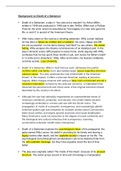Background on Death of a Salesman
Death of a Salesman, a play in “two acts and a requiem” by Arthur Miller,
written in 1948 and produced in 1949 (set in late 1940s). Miller won a Pulitzer
Prize for the work, which he described as “the tragedy of a man who gave his
life, or sold it” in pursuit of the American Dream.
After many years on the road as a traveling salesman, Willy Loman realizes
he has been a failure as a father and a husband. His sons, Happy and Biff,
are not successful—on his terms (being “well liked”) or any others. His career
fading, Willy escapes into dreamy reminiscences of an idealized past. In the
play’s climactic scene, Biff prepares to leave home, starts arguing with Willy,
confesses that he has spent three months in jail, and mocks his father’s belief
in “a smile and a shoeshine.” Willy, bitter and broken, his illusions shattered,
commits suicide. Loss of identity.
Death of a Salesman, Miller’s most famous work, addresses the painful
conflicts within one family, but it also tackles larger issues regarding American
national values. The play examines the cost of blind faith in the American
Dream. In this respect, it offers a post-war American reading of personal
tragedy. Miller charges America with selling a false myth constructed around a
capitalist materialism nurtured by the post-war economy, a materialism that
obscured the personal truth and moral vision of the original American Dream
described by the country’s founders.
Although the war had ostensibly engendered an unprecedented sense of
American confidence, prosperity, and security, the United States became
increasingly embroiled in a tense cold war with the Soviet Union. The
propagation of myths of a peaceful, homogenous, and nauseatingly gleeful
American golden age was tempered by constant anxiety about Communism,
bitter racial conflict, and largely ignored economic and social stratification.
Many Americans could not subscribe to the degree of social conformity and
the ideological and cultural orthodoxy that a prosperous, booming,
conservative suburban middle-class championed.
Death of a Salesman explores the psychological chaos of the protagonist, the
aptly-named Willy Loman, his belief in providing for his family and leaving a
legacy behind after death, and the capitalist society’s impact on his life. The
psychological and philosophical considerations cannot be detached fully from
the anti-capitalist message, but they have arguably stood the test of time
better.
The play was originally called ‘The Inside of His Head’, because of its unusual
structure. The action jumps around in time and chronology is manipulated




